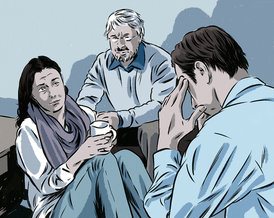
"Trauma victims, van der Kolk likes to say, are alienated from their bodies by a cascade of events that begins deep in the brain with an almond-shaped structure known as the amygdala. When faced with a threat, the amygdala triggers a fight-or-flight response, which includes the release of a flood of hormones. This response usually persists until the threat is vanquished. But if the threat isn’t vanquished — if we can’t fight or flee — the amygdala, which can be thought of as the body’s smoke detector, keeps sounding the alarm. We keep producing stress hormones, which in turn wreak havoc on the rest of our bodies. It’s similar to what happens in chronic stress, except that in traumatic stress, the memories of the traumatic event invade patients’ subconscious thoughts, sending them back into fight-or-flight mode at the slightest provocation. Therapists and patients refer to this as being “reactivated.” In the short term, patients avoid the pain it causes by “dissociating ... The goal of treatment should be to resolve this disconnect. “If we can help our patients tolerate their own bodily sensations, they’ll be able to process the trauma themselves,” he says” (NY Times).
 RSS Feed
RSS Feed
